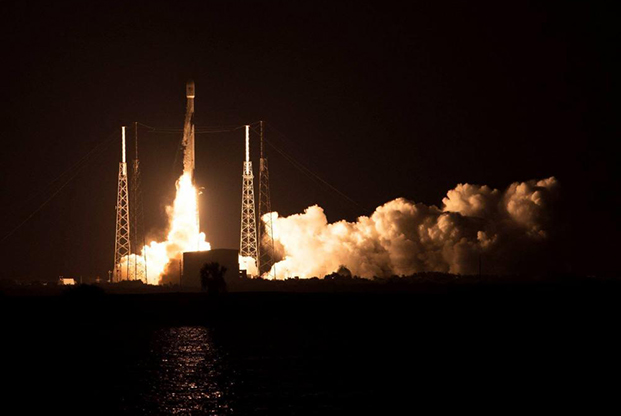
The authors of the Woomera Manual are trying aim to finish a draft by the beginning of 2020, then allow 12-18 months for “state engagement.” Air Force photo by A1C Zoe Thacke.
Increased activity and competition in space risks future conflict unless the international community can define common legal norms for commercial and military activity in space, legal scholars say.
At least eight nations are currently involved in trying to define how international law should govern military operations in space. Scholars from the eight are developing a comprehensive, unofficial manual defining military and government consensus on how international law addresses war in space, much as the Tallinn Manual has done for the application of international law in military cyberspace operations.
The Woomera Manual—named for the remote air and space facility in the Australian desert—will document how nations interpret the brief and rather vague language of the five major international treaties governing the military use of space, as well as how they apply other international laws and treaties to space, according to US Air Force Maj. Susan Trepczynski, the staff judge advocate for the USAF National Air and Space Intelligence Center.
“Everyone knows what law applies [to military operations] in space,” she told a gathering at an American Bar Association law and national security conference Nov. 1. “We may not know exactly what it means, but if you’re doing military operations in space, you know where to look it up and you have to apply it.”
What the manual’s authors hope to document is how “different states are applying that law in practice,” Trepczynski said, adding that she and the other participants are working in a voluntary capacity.
Current and former officials and experts from the US, Australia, Britain, Canada, France, Germany, India, Singapore, and Sweden—as well as a law professor from China—are taking part in the three-year effort based at the University of Adelaide in Australia. They are supported by technical experts on space and engineering.
Getting buy-in from governments is crucial to the authors’ aim of creating a handbook that will be useful to practitioners, said University of Adelaide Prof. Melissa de Zwart.
“To be useful,” she said, “It has to be supported by countries: They have to agree that it reflects their views.”
The authors aim to complete a draft by the beginning of 2020, then allow 12-18 months for “state engagement.”
“It’s very important to us that we get feedback from states, in terms of ‘Does this actually reflect how you understand the law as it applies to space operations,’” de Zwart told Air Force Magazine.
The five international space treaties, all signed between 1967 and 1973, address “broad principles, not detailed nuanced law that tells you every single thing you’re going to do in space,” Trepczynski said. When they were signed, the US and Soviet Union were in the throes of the Cold War and could never have reached agreement on something much more detailed.
“The broad strokes of space law leave a lot of room for state practice,” de Zwart said, so nations could interpret the law as they saw fit.
Unlike later arms control deals, which bristle with detail and include voluminous appendices, the space treaties are very brief—only 20 pages altogether, Trepczynski noted. Gaps are numerous. As a result, she added, “You have to look at what the rest of international law says to fill those holes … You look at the UN Charter and the Law of Armed Conflict” and see how they apply.
Moreover, the treaties’ provisions have been largely left behind by the enormous transformation wrought in how space is used.
“Military activities have been a part of what’s going on in space since the very beginning,” Trepczynski said. “What’s changed is what else is going on up there … the evolution in the importance of the domain to everyday life” for communication, navigation, and other purposes.
“Space is pervasive in daily life in a way it wasn‘t when the space age started,” Trepczynski said, “and in a way it wasn‘t when the treaties were written.”
The growing commercial use of satellites to track shipments, monitor crops, aid communication and navigation, and more mean Woomera authors must weigh broader elements of the space treaties, said Prof. Jack Beard, from the University of Nebraska.
For example, the Outer Space Treaty states that nations are responsible for “national activities” in space—whether those are governmental or not, Beard said. “The launching state is liable for any damage caused by an object it launches. But who is the ‘launching state’ when the [government of the United Kingdom] pays a US company to launch a satellite from a facility on Australian territory?”
It’s also unclear which nation has “the broader international responsibility … and the related duty” to supervise the object once it’s in orbit, he said.
The authors aim to clarify “these and other space law issues that have civilian aspects but are also relevant to military operations.”
Future commercial endeavors will be still more complex. “There’s no sovereignty over celestial bodies” under the law, Beard explained. “You can’t claim dominion or sovereignty” over an asteroid or a planet. “But what about mining? Can you claim ownership over resources once they’ve been extracted?”
A research probe has already landed on an asteroid. If there are valuable resources in space, he adds, “they will be exploited … It’s only a matter of time.”
Without clear law, the world risks commercial competition spilling over into direct state-to-state confrontation.
“There’s never been a situation where humans have gone somewhere new and not got into conflict,” Beard said. “That’s why we need to clarify how existing space law and the law of armed conflict would govern future military operations in space.”
